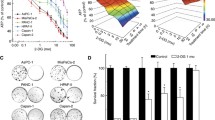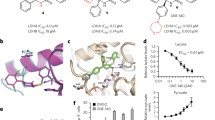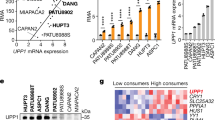Abstract
Background
As tumors evolve, they upregulate glucose metabolism while also encountering intermittent periods of glucose deprivation. Here, we investigate mechanisms by which pancreatic cancer cells respond to therapeutic (2-deoxy-d-glucose, 2-DG) and physiologic (glucose starvation, GS) forms of glucose restriction.
Methods
From a tumor cell line (1420) that is unusually sensitive to 2-DG under normoxia, low (14DG2)- and high (14DG5)-dose resistant cell lines were selected and used to probe the metabolic pathways involved with their response to different forms of glucose deprivation.
Results
Muted induction of the unfolded protein response was found to correlate with resistance to 2-DG. Additionally, 14DG2 displayed reduced 2-DG uptake, while 14DG5 was cross-resistant to tunicamycin, suggesting it has enhanced ability to manage glycosylation defects. Conversely, 2-DG-resistant cell lines were more sensitive than their parental cell line to GS, which coincided with lowered levels of glycogen phosphorylase (PYGB) and reduced breakdown of glycogen to glucose in the 2-DG-resistant cell lines. Moreover, by inhibiting PYGB in the parental cell line, sensitivity to GS was increased.
Conclusions
Overall, the data demonstrate that the manner in which glucose is restricted in tumor cells, i.e., therapeutic or physiologic, leads to differential biological responses involving distinct glucose metabolic pathways. Moreover, in evolving tumors where glucose restriction occurs, the identification of PYGB as a metabolic target may have clinical application.






Similar content being viewed by others
Abbreviations
- 2-DG:
-
2-Deoxy-d-glucose
- GS:
-
Glucose starvation
- UPR:
-
Unfolded protein response
- LLO:
-
Lipid-linked oligosaccharide
- ER:
-
Endoplasmic reticulum
- Grp78:
-
Glucose-regulated protein 78 kDa
- PERK:
-
PKR-like ER kinase
- CHOP:
-
C/EBP-homologous protein
- LC3B:
-
Autophagy marker light chain 3
- FACE:
-
Fluorophore-assisted carbohydrate electrophoresis
- GYS:
-
Glycogen synthase 1
- PYGB:
-
Glycogen phosphorylase brain isoform
- TM:
-
Tunicamycin
- BFA:
-
Brefeldin A
- AMPK:
-
AMP-activated protein kinase
- CaMKKβ:
-
Ca2+/calmodulin-dependent protein kinase kinase-beta
- ROS:
-
Reactive oxygen species
- ERK:
-
Extracellular signal-regulated kinases
- SREBF1:
-
Sterol regulatory element-binding transcription factor 1
- SREBF2:
-
Sterol regulatory element-binding transcription factor 2
- INSIG1:
-
Insulin-induced gene 1
- INSIG2:
-
Insulin-induced gene 2
- SCAP:
-
SREBF chaperone
- MBTPS1:
-
Membrane-bound transcription factor peptidase site 1
- MBTPS2:
-
Membrane-bound transcription factor peptidase site 2
- Rapa:
-
Rapamycin
- 3-MA:
-
3-Methyladenine
References
Chen J, Russo J (2012) Dysregulation of glucose transport, glycolysis, TCA cycle and glutaminolysis by oncogenes and tumor suppressors in cancer cells. Biochim Biophys Acta 1826:370–384
Dang CH (2012) Links between metabolism and cancer. Genes Dev 26:877
Ying H, Kimmelman A, Lyssiotis C, Hua S, Chu G, Fletcher-Sananikone E, Locasale J, Son J, Zhang H, Coloff J, Yan H, Wang W, Chen S, Viale A, Zheng H, Paik J, Lim C, Guimaraes A, Martin E, Chang J, Hezel A, Perry S, Hu J, Gan B, Xiao Y, Asara J, Weissleder R, Wang Y, Chin L, Cantley L, DePinho R (2012) Oncogenic kras maintains pancreatic tumors through regulation of anabolic glucose metabolism. Cell 149:656–670
Papetti M, Herman IM (2002) Mechanisms of normal and tumor-derived angiogenesis. Am J Physiol Cell Physiol 282:C947–C970
Izuishi K, Kato K, Ogura T, Kinoshita T, Esumi H (2000) Remarkable tolerance of tumor cells to nutrient deprivation: possible new biochemical target for cancer therapy. Cancer Res 60:6201
Maher JC, Wangpaichitr M, Savaraj N, Kurtoglu M, Lampidis TJ (2007) Hypoxia-inducible factor-1 confers resistance to the glycolytic inhibitor 2-deoxy-D-glucose. Mol Cancer Ther 6:732
Raez LE, Papadopoulos K, Ricart AD, Chiorean EG, DiPaola RS, Stein MN, Rocha Lima CM, Schlesselman JJ, Tolba K, Langmuir VK, Kroll S, Jung DT, Kurtoglu M, Rosenblatt J, Lampidis TJ (2012) A phase I dose-escalation trial of 2-deoxy-D-glucose alone or combined with docetaxel in patients with advanced solid tumors. Cancer Chemother Pharmacol 71:523–530
Maher JC, Krishan A, Lampidis TJ (2004) Greater cell cycle inhibition and cytotoxicity induced by 2-deoxy-D-glucose in tumor cells treated under hypoxic vs aerobic conditions. Cancer Chemother Pharmacol 53:116
Kurtoglu M, Gao N, Shang J, Maher JC, Lehrman MA, Wangpaichitr M, Savaraj N, Lane AN, Lampidis TJ (2007) Under normoxia, 2-deoxy-D-glucose elicits cell death in select tumor types not by inhibition of glycolysis but by interfering with N-linked glycosylation. Mol Cancer Ther 6:3049
Lehrman MA (2006) Stimulation of N-linked glycosylation and lipid-linked oligosaccharide synthesis by stress responses in metazoan cells. Crit Rev Biochem Mol Biol 41:51
Zhang K, Kaufman RJ (2006) Protein folding in the endoplasmic reticulum and the unfolded protein response. Handb Exp Pharmacol 172:69
Lee AS (2007) GRP78 induction in cancer: therapeutic and prognostic implications. Cancer Res 67:3496–3499
Chakrabarti A, Chen AW, Varner JD (2011) A Review of the mammalian unfolded protein response. Biotechnol Bioeng 108:2777–2793
Zinszner H, Kuroda M, Wang X, Batchvarova N, Lightfoot RT, Remotti H, Stevens JL, Ron D (1998) CHOP is implicated in programmed cell death in response to impaired function of the endoplasmic reticulum. Genes Dev 12:982
Mutlu AD, Cavallin LE, Vincent L, Chiozzini C, Eroles P, Duran EM, Asgari Z, Hooper AT, La Perle KM, Hilsher C, Gao SJ, Dittmer DP, Rafii S, Mesri EA (2007) In vivo-restricted and reversible malignancy induced by human herpesvirus-8 KSHV: a cell and animal model of virally induced Kaposi’s sarcoma. Cancer Cell 11:245
Gao N, Lehrman MA (2006) Non-radioactive analysis of lipid-linked oligosaccharide compositions by fluorophore-assisted carbohydrate electrophoresis. Methods Enzymol 415:3
Louzao MC, Espiña B, Vieytes MR, Vega FV, Rubiolo JA, Baba O, Terashima T, Botana LM (2008) “Fluorescent glycogen” formation with sensibility for in vivo and in vitro detection. Glycoconj J 25:503
Rutkowski DT, Kaufman RJ (2004) A trip to the ER: coping with stress. Trends Cell Biol 14:20–28
Maher JC, Savaraj N, Priebe W, Liu H, Lampidis TJ (2005) Differential sensitivity to 2-Deoxy-D-glucose between two pancreatic cell lines correlates with GLUT1 expression. Pancreas 30:34
Xi H, Kurtoglu M, Liu H, Wangpaichitr M, You M, Liu X, Savaraj N, Lampidis TJ (2011) 2-Deoxy-D-glucose activates autophagy via endoplasmic reticulum stress rather than ATP depletion. Cancer Chemother Pharmacol 67:899
Elbein AD (1984) Inhibitors of the biosynthesis and processing of N-linked oligosaccharides. CRC Crit Rev Biochem 16:21
Nebenführ A, Ritzenthaler C, Robinson DG (2002) Brefeldin A: deciphering an enigmatic inhibitor of secretion. Plant Physiol 130:1102
Henke BR, Sparks SM (2006) Glycogen phosphorylase inhibitors. Mini Rev Med Chem 6:845–857
Kurtoglu M, Maher JC, Lampidis TJ (2007) Differential toxic mechanisms of 2-deoxy-D-glucose versus 2-fluorodeoxy-D-glucose in hypoxic and normoxic tumor cells. Antioxid Redox Signal 9:1383
Datema R, Schwarz RT (1978) Formation of 2-deoxyglucose-containing lipid linked oligosaccharides. Interference with glycosylation of glycoproteins. Eur J Biochem 90:505
Merchan JR, Kovács K, Railsback JW, Kurtoglu M, Jing Y, Piña Y, Gao N, Murray TG, Lehrman MA, Lampidis TJ (2010) Antiangiogenic activity of 2-deoxy-D-glucose. PLOS ONE 5(10):e13699. doi:10.1371/journal.pone.0013699
Baumann H, Jahreis GP (1983) Glucose starvation leads in rat hepatoma cells to partially N-glycosylated glycoproteins including alpha 1-acid glycoproteins. Identification by endoglycolytic digestions in polyacrylamide gels. J Biol Chem 258:3942–3949
Kim R, Emi M, Tanabe K, Murakami S (2006) Role of the unfolded protein response in cell death. Apoptosis 11:5
Fears R (1981) The contribution of the cholesterol biosynthetic pathway to intermediary metabolism and cell function. Biochem J 199:1
Buhaescu I, Izzedine H (2007) Mevalonate pathway: a review of clinical and therapeutical implications. Clin Biochem 40:575–584
Park H, Tomida A, Sato S, Tsukumo Y, Yun J, Yamori T, Hayakawa Y, Tsuruo T, Shin-ya K (2004) Effect on tumor cells of blocking survival response to glucose deprivation. J Natl Cancer Inst 96:1300–1310
Xi H, Barredo JC, Merchan JR, Lampidis TJ (2013) Endoplasmic reticulum stress induced by 2-deoxyglucose but not glucose starvation activates AMPK through CaMKKβ leading to autophagy. Biochem Pharmacol 85:1463–1477
Mihaylova MM, Shaw RJ (2011) The AMPK signalling pathway coordinates cell growth, autophagy and metabolism. Nat Cell Biol 13:1016
Lavoie S, Allaman I, Petit JM, Do KQ, Magistretti PJ (2011) Altered glycogen metabolism in cultured astrocytes from mice with chronic glutathione deficit; relevance for neuroenergetics in schizophrenia. PLoS ONE 6
Favaro E, Bensaad K, Chong M, Tennant D, Ferguson DP, Snell C, Steers G, Turley H, Li J, Günther U, Buffa F, McIntyre A, Harris A (2012) Glucose utilization via glycogen phosphorylase sustains proliferation and prevents premature senescence in cancer cells. Cell Metab 16:751–764
Ben-Yoseph O, Boxer PA, Ross BD (1996) Assessment of the role of the glutathione and pentose phosphate pathways in the protection of primary cerebrocortical cultures from oxidative stress. J Neurochem 66:2329–2337
Schnier JB, Nishi K, Monks A, Gorin FA, Bradbury EM (2003) Inhibition of glycogen phosphorylase (GP) by CP-91,149 induces growth inhibition correlating with brain GP expression. Biochem Biophys Res Commun 309:126–134
Shaw RJ (2006) Glucose metabolism and cancer. Curr Opin Cell Biol 18:598–608
Gillies RJ, Robey I, Gatenby RA (2008) Causes and consequences of increased glucose metabolism of cancers. J Nucl Med 49:24S–42S
Pauwels EKJ, Ribeiro MJ, Stoot JHMB, McCready VR, Bourguignon M, Mazière B (1998) FDG accumulation and tumor biology. Nucl Med Biol 25:317–322
Acknowledgments
We would like to thank Dr. Otto Baba (Department of Hard Tissue Engineering, Tokyo Medical and Dental University, Tokyo, Japan) for kindly providing the anti-glycogen antibody. We are grateful to the following persons from University of Miami for their technical support on the following: Dr. Eli Gilboa and Dr. Mansoor Ahmed for radioactive uptake assays, Dr. Enrique Mesri for qPCR and David Siefker for fluorescent microscopy. We also want to acknowledge the following for thoughtful discussions and insights on this work: Dr. Niramol Savaraj (University of Miami), Dr. Medhi Wangpaichitr (University of Miami) and Dr. Haibin Xi (University of California Los Angeles). This work was supported by National Cancer Institute grant CA37109 and Pap Corps award to TJL and National Institute of General Medical Sciences grant GM38545 to MAL.
Author information
Authors and Affiliations
Corresponding author
Electronic supplementary material
Below is the link to the electronic supplementary material.
280_2013_2358_MOESM1_ESM.ppt
Figure S1. Autophagy induction does not correlate with resistance to 2-DG. a 1420, 14DG2 and 14DG5 cells were treated with the indicated doses of 2-DG for 24 h under normoxia then harvested and immunoblotting was performed to detect protein levels of Beclin and LC3B cleavage in the four cell lines. β-Actin was used as a loading control. b Cells were treated with the indicated doses of 3-MA and 2-DG for 72 h in normoxia and percent dead cells was assayed by trypan blue exclusion. The bars represent the average of triplicate samples ± SD. c Cell lines were treated with the indicated doses of rapamycin and 2-DG for 72 h in normoxia and percent dead cells was assayed by trypan blue exclusion. The bars represent the average of triplicate samples ± SD (PPT 231 kb)
280_2013_2358_MOESM2_ESM.ppt
Figure S2. Resistant cell lines not maintained with 2-DG display unique phenotypes. a Cell lines were treated with the indicated doses of 2-DG for 72 h in normoxia and percent dead cells was assayed by trypan blue exclusion. The bars represent the average of triplicate samples ± SD. ** P < 0.01, *** P < 0.001 as compared with 14DG2. b 1420, 14DG2 and 14DG5 cell lines were challenged with GS for 72 h in normoxia and percent dead cells was assayed by trypan blue exclusion. The bars represent the average of triplicate samples ± SD. * P < 0.05, ** P < 0.01, 14DG2NM is compared to 14DG2; 14DG5NM is compared to 14DG5. c Immunoblotting was performed to detect basal protein levels of PYGB in the four cell lines. β-Actin was used as a loading control. Quantification can be seen at right of blot (PPT 200 kb)
Rights and permissions
About this article
Cite this article
Philips, K.B., Kurtoglu, M., Leung, H.J. et al. Increased sensitivity to glucose starvation correlates with downregulation of glycogen phosphorylase isoform PYGB in tumor cell lines resistant to 2-deoxy-d-glucose. Cancer Chemother Pharmacol 73, 349–361 (2014). https://doi.org/10.1007/s00280-013-2358-8
Received:
Accepted:
Published:
Issue Date:
DOI: https://doi.org/10.1007/s00280-013-2358-8




